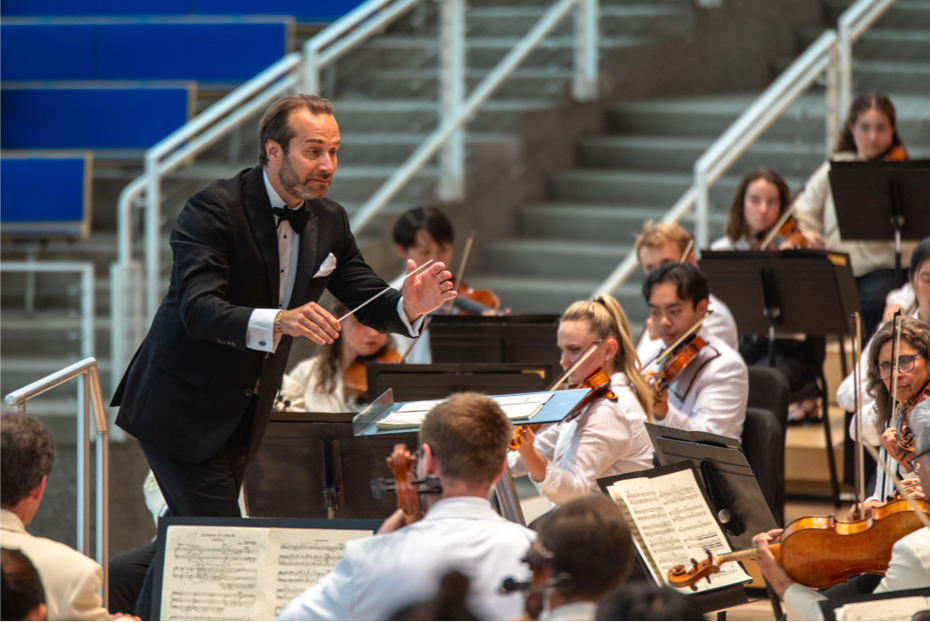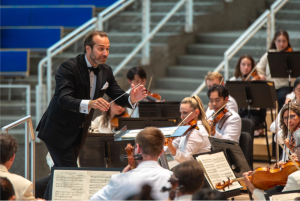Conductor, pianist make a big splash in Sunday’s Festival Orchestra program

Blake Nelson/Courtesy photo
Conductor Fabien Gabel and pianist Seong-Jin Cho made vivid returns to Aspen Sunday afternoon. It wasn’t just their jaw-droppingly delicious romp through the Mendelssohn Piano Concerto No.1. Start to finish, the Aspen Festival Orchestra program was by far the best so far this season in the Klein Music Tent.
Huge credit to Gabel for that. A one-time student here, now the music director of Lower Austria’s Tonkünstler Orchestra, he coaxed magnificent playing in works by Ravel and Richard Strauss too. Whether it was finding ideal balances within the orchestra in the big, expressive moments, allowing all the layers of sound room to breathe, or setting ideal paces to keep momentum in every piece on the program, the results were thrilling.
Let’s start with the concerto. Sure, it’s not Mendelssohn’s deepest music, but it’s a crowd-pleaser, especially the “cancan” finale. Gabel got the music racing at a fast pace, yet kept everything sprightly for Cho to dazzle us with effortless playing no matter how difficult it might be just to play the notes. It wasn’t only keyboard technique, but a canny sense of how it all fit together, shading dynamics at a blink, getting crisp sound out of the piano and making it flow when the slow movement needed to do just that.
The other soloist on the program, soprano Ana María Martínez, spun out Ravel’s gorgeous melodies in the three-part Schéhérezade. “La flûte enchantée” was especially arresting as her silken soprano and principal flutist Nadine Asin both excelled, and the finale, “L’indifferent,” wafted to a gentle finish with voice and orchestra blending as one.
The opening piece, the Strauss tone poem Death and Transfiguration, bloomed with color from the top. The low woodwinds growled in the opening measures, and the tension rose ever so gradually as elements of the music came together. Gabel seemed to be probing to find where the music could become even more expressive, eventually reaching a series of climaxes. The big brass chorales in the final moments were ideally separated by catchings of breaths before the next one.
Best of all was the last item on the program, Ravel’s “Daphnis et Chloé” Suite No.2. Everything came together seamlessly. The sun rose in the opening “Daybreak,” the sections of the orchestra coalescing and expanding into glorious colors, all the while keeping the pace moving with urgency. The more reflective “Pantomime” contained another superb Asin solo, her flute sailing in tribute to Pan’s flute from the original ballet.
It just got better in the finale. The celebration of the couple’s wedding vows grew organically from simple folk-like dance tunes to a towering example of Ravel’s orchestral brilliance and barely restrained rhythms from the large percussion section.
In contrast, Friday’s Chamber Symphony program was designed as a big musical hug, balm for difficult times in the form of three magnificent works by English composers offering consolation.
A contemporary of Vaughan Williams wrote that the composer’s Symphony No.5, which made its debut in the midst of World War II, was “the most benedictory and consoling music of our time.” It certainly fit this season’s theme of the spiritual in music. Programming the Elgar Cello Concerto in the first half delivered on that front, as did Steven Stucky’s 10 minute 1991 expansion on Purcell’s Funeral Music for Queen Mary.
Stucky’s beautifully orchestrated, deftly reworked version of Purcell was an un-alloyed success. The stately pace that slowed down Elgar and Vaughan Williams paid dividends in the funeral music, especially the buildups to sonorous brass chorales.
To a large extent the other pieces created the warmth, gorgeous sound and supple textures required. Conductor Robert Spano may have aimed for a stately pace to emphasize these aspects of the music, but the result missed the rhythmic elements that frame them.
In the concerto, soloist Zlatomir Fong (also a rising star in the classical music world) lingered enticingly over individual moments of delicacy and grace, even as the music around it didn’t quite bloom. The first movement’s moderato felt more like an andante, and the second movement’s allegro molto more like a moderato. The adagio was the highlight of the concerto, offered with a sense of reverence.
In the symphony, the slow paces blurred any intended contrasts between the movements. The faster ones never reached the frantic feeling intended to make the expansive finale a sort of balm. The second movement Scherzo, marked in the score “presto misterioso,” never got past a sort of allegretto, so the musical jokes (“scherzo” literally means “joke”) did not spring. The third movement Romanza did emphasize rich sonorities and a gentle touch.
Throughout, there were lovely solos by several of the orchestra’s principals, especially English horn player Will Simpfendorfer, and it all came together in the finale’s passacaglia. The composer’s setting of hopeful, hymn-like phrases rose to a sonorous climax before settling into a soft, prayer-like finish.
More rewarding was the Brentano String Quartet’s Aspen debut recital Saturday evening in Harris Hall. There’s nothing flashy about the Brentano. They file on stage, sit down, tune, and get to the business of delving into music with an acumen that, in the end, just makes sense.
The three pieces on their program, all from the German-speaking European canon — Schubert’s String Quartet No.13 “Rosamunde,” Webern’s Five Movements (op.5), and Brahms’ String Quartet No.3 in B-flat major — made for a satisfying evening. The music unfolded without any effort to push boundaries.
The Brahms was especially fine, lithe and bouncy, relishing joying the composer’s unexpectedly light hand with rhythms in this late quartet. Even Brahms called it Haydn-esque. The controlled zest with which the quartet played it made it absolutely delightful.
In giving the five short Webern pieces distinctively different sonorities, they achieved a sort of apotheosis of grieving harmonies when they got to the last one. In contrast, the opening Schubert quartet emphasized melody (such as the one the composer lifted from his failed opera, “Rosamunde,” in the lovely slow movement) among the shifting moods and harmonies.
If this quartet is asked back to Aspen, it would be rewarding to hear music they have commissioned, including works by Matthew Aucoin, Vijay Iyer, and Steven Mackey.
Not to miss in the coming days: In tonight’s special event at Harris Hall, pianist Seong-Jin Cho takes on every note Maurice Ravel ever wrote for solo piano. There’s more Ravel at the tent on Friday’s Chamber Orchestra program (the Mother Goose Suite), which also includes conductor Matthias Pinscher’s violin concerto, to be played by Blake Pouliot. And if you couldn’t make it to the first performance of the Renée Fleming-directed “Così fan tutte,” there will be two more opportunities to catch the Mozart opera Wednesday and Saturday at the Wheeler.
Harvey Steiman has been writing about the Aspen Music Festival for more than 30 years. His reviews appear in The Aspen Times Tuesdays and Saturdays.









